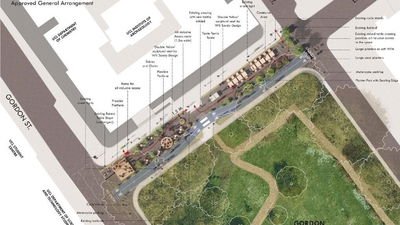A key street lying between Gordon Square and University College London’s (UCL) Institute of Archaeology has been completely transformed from a lifeless space to a streetscape that now buzzes with life.

From loading yard to green campus
Gordon Square is a small public park in central London that dates from the 1820s and is managed by UCL to encourage wildlife. While London’s squares provide key green spaces throughout the city, they sit in isolation and are generally surrounded by busy streets. They are often privately owned and managed so are not always the most openly welcoming of places for everyone.
Along the northern edge of the square, Gordon Street had previously been a loading yard, before being opened to traffic. For students whose city campus is made up of the streets around their faculties, accessibility is often challenging, and the streets can present a barrier to full accessibility. To address the well understood threats of isolation, loneliness, air quality and lack of access to nature, the creation of green outdoor meeting places is vital for everyone.
A key to greening London
LDA Design are well known for many projects where they have successfully transformed busy London streetscapes into welcoming social meeting places for all. Their portfolio is filled with projects that give streets back to people and nature.
Through their work with Camden Council and UCL in partnership, this ‘meanwhile’ phase will test the future pedestrianisation of Gordon Street and is just one project of Camden Council’s ‘Bloomsbury Green Corridor’ initiative.
This proposed green route will run right through one of London’s busiest areas, providing north-south walking and cycling routes from Euston Road to the River Thames.
This project, located immediately outside the prestigious university’s Archaeology department, is the first of a number of improvements that are planned in the coming years. The overarching aim is to make Camden’s streets safer and healthier by improving both the pedestrian environment and air quality through the removal of through traffic. UCL’s own vision for the space is that it will play a key part in their Bicentennial celebrations in 2026.
A new home for people and nature
The street’s transformation to a colourful community space has enhanced the local area for students, staff, residents and visitors. Students and staff are thrilled to have an attractive new green space on their doorstep and instantly adopted this brand-new part of their campus.
The space now serves everyone, no matter their needs, with a new cycle lane, cycle parking, seating and planters, all of which have dramatically improved the public realm. Many large planters have been used to close off and define the space and are filled with pollinator-friendly planting, along with insect hotels to encourage and support biodiversity. The varied seating options, in three shades of green and a complementary brown/grey, offer plenty of choices for meeting, relaxing, eating or working. Through a simple yet effective design approach, the suite of urban furniture has completely transformed the area into a vibrant pedestrian and nature focussed space.
Products:
Stripes (small, standard, mega) seating 3610/3612/3613
Stripes planter 3674/3684
Habitats planters 5880
Habitats Leaf 5906
April table 731
April GO chairs 7013/7014
Vroom table 636
Code Square 2616
Porto 406/427
Colours:
RAL6011 Reseda Green
RAL6018 Yellow Green
Client: Camden Council/University College London
Landscape/Highways Architect: LDA Design/ Highways & Infrastructure: Norman Rourke Pryme
Contractor: F M Conway
Planting: Tivoli
Completion: May 2024
Location: Gordon Square, Bloomsbury, London
Sector: Education, public realm & cultural

Revierparks 2020+: Sustainable transformation with Vestre urban furniture brings new quality of life to the Ruhr region
Source: vestre.com


